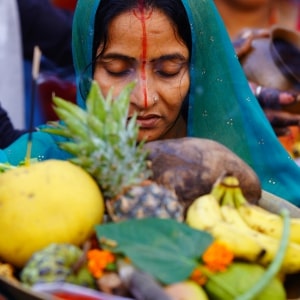Chhath Puja, a traditional Hindu festival dedicated to the worship of the Sun God, is celebrated with immense fervor and devotion in various parts of India, particularly in the states of Bihar, Jharkhand, Uttar Pradesh, and Nepal. One crucial aspect of the Chhath Puja celebrations is the preparation and use of specific items, collectively known as “Chhath Puja Samagri.” In this article, we will delve into the significance of Chhath Puja and explore the essential items required for the auspicious rituals.

Chhath Puja Significance
Chhath Puja is a unique and ancient Hindu festival that is dedicated to Lord Surya, the Sun God, and Chhathi Maiya, believed to be the consort of Lord Surya. Celebrated six days after Diwali, Chhath Puja is observed to express gratitude towards the Sun God for sustaining life on Earth and seeking blessings for prosperity and well-being. The rituals involve fasting, offering prayers, and performing various customs on the ghats (riverbanks) during sunrise and sunset.
Chhath Puja Samagri
Chhath Puja Samagri comprises a list of essential items required for the meticulous observance of the rituals associated with the festival. Each item holds symbolic importance and plays a crucial role in the worship of the Sun God. Here is a comprehensive list of Chhath Puja Samagri:
- Thekua: These are traditional wheat-based cookies that are an integral part of Chhath Prasad (offering). Thekua is prepared with jaggery, wheat flour, and ghee, offering a unique blend of taste and religious significance.
- Daura: A small basket made of bamboo or cane, the daura is used to carry the offerings and other essential items to the riverbank where the Chhath Puja rituals take place.
- Soop (Tray): The soop or tray is used to hold the Prasad and other items during the worship. It is traditionally made of bamboo sticks.
- Ghee: Pure clarified butter, or ghee, is used in the preparation of various offerings and is considered sacred in Hindu rituals.
- Mauli (Sacred Thread): A red or yellow sacred thread, known as mauli, is tied around the wrist of the devotees and is believed to bring good luck and protection.
- Fruits: Offerings of seasonal fruits such as sugarcane, bananas, and coconuts are made to the Sun God as a symbol of gratitude for the bounties of nature.
- Dhoop and Diya: Incense sticks (dhoop) and earthen lamps (diya) are lit during the evening rituals, symbolizing the dispelling of darkness and the triumph of light.
- Ganga Jal (Holy Water): Devotees use water from the sacred Ganges River for various purification rituals during Chhath Puja.
- Red Cloth: A piece of red cloth is used to spread over the daura and soop, symbolizing the purity and auspiciousness of the offerings.
Also Read: Why Do We Celebrate Chhath Puja?
Chhath Puja Samagri holds immense cultural and religious significance in the observance of Chhath Puja, a festival that resonates with devotion and gratitude towards the Sun God. The meticulous preparation and use of these items add depth to the rituals, creating a spiritually enriching experience for the devotees. As Chhath Puja continues to be celebrated with great enthusiasm, understanding the importance of Chhath Puja Samagri becomes crucial for those partaking in this ancient and revered festival.





